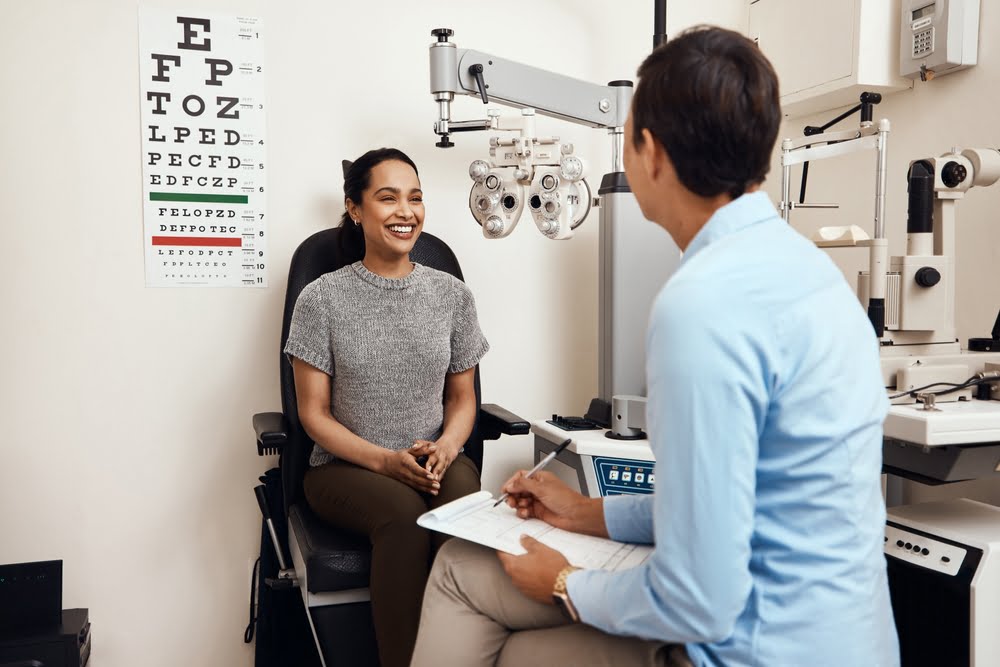
Fast-progressing nearsightedness, or myopia, in children is a growing concern that demands your attention. Myopia makes distant objects appear blurry while close ones remain clear.
This article explores effective ways to manage myopia, including spectacles, contact lenses, and atropine eye drops. Furthermore, practices like spending over 90 minutes outside daily can significantly slow down myopia’s progression.
Keep reading for insights on protecting your children’s vision. Future awaits!
What is Myopia and how does it progress?
Myopia, or nearsightedness, means you can see objects close to you clearly, but things farther away are blurry. This vision issue happens when the shape of your eye causes light rays to bend incorrectly, focusing images in front of your retina instead of on it.
With progressive myopia in children, this condition worsens over time due to factors such as genetics or environmental influences.
Understanding the development of myopia is crucial for controlling its progression in children. Effective control focuses on treatments that keep nearsightedness from getting worse.
Causes of Myopia
- spending long hours focusing on close objects like books or screens
- genetics
- lack of outdoor activity
- continuous exposure to screen without breaks
Impact of Myopia on Children
Myopia can significantly affect a child’s daily activities, limiting their ability to see objects at a distance clearly.
This hindrance can impact learning and participation in school, leading to academic challenges. It often requires them to wear glasses or contact lenses, which might affect their self-esteem and social interactions.
Children with nearsightedness may also face difficulties in engaging in outdoor sports or activities because of their impaired vision. This limitation not only affects physical health but also limits opportunities for social development with peers.
The progression of myopia increases the risk of developing serious eye conditions later in life, such as retinal detachment, glaucoma, and cataracts.
Methods for Myopia Control
Discover a variety of effective strategies to control the swift progression of myopia in children and help them maintain better vision health. Explore these innovative methods to find hope and solutions for your child’s nearsightedness.
Low-Dose Atropine Eye Drops
Low-dose atropine eye drops, specifically the 0.05% concentration, stand as one of the promising options for controlling myopia progression in children. Your eye care professional may prescribe these drops to be used once daily.
The goal is to slow down the rate at which nearsightedness worsens. Unlike glasses or regular contact lenses that only correct vision, low-dose atropine works by relaxing the eye’s focusing mechanism and reducing strain.
Peripheral Defocus Contact Lenses
Peripheral defocus contact lenses work by altering the way light enters your child’s eyes. These contacts focus light directly on the retina while also shifting some of the focus in front of and behind it.
This unique approach is designed to slow the progression of myopia by providing a signal to the eye that reduces its elongation over time.
These lenses are specially crafted for daily wear, offering both correction for nearsightedness and a strategy to control its advancement. Eye care professionals carefully prescribe them after evaluating your child’s specific needs, ensuring they fit comfortably and effectively manage myopia progression.
Orthokeratology (Ortho-K)
Orthokeratology, or Ortho-K, is a powerful way to control myopia in children. This technique involves wearing specially designed contact lenses overnight that gently reshape the cornea.
When your child wakes up and removes the lenses, they can see clearly during the day without needing glasses or contacts. Studies show that Ortho-K can slow down myopia progression by nearly 50% in most cases.
The process works best when started early, as it helps keep nearsightedness from getting worse. By using Ortho-K lenses, you provide your child with an effective tool against rapid myopia progression while avoiding the need for daytime corrective wear.
Steps for Parents and Children to Take to Slow Myopia Progression
Slowing down the progression of myopia in children requires a combined effort from both parents and kids. Implement simple lifestyle changes and habits to keep your child’s vision healthy and stable.
Encourage Outdoor Time
Make sure your child spends over 90 minutes outside every day. Studies show that outdoor activities can significantly slow down myopia progression in children. Sunlight and engagement with distant objects play a crucial role in eye health, helping to keep nearsightedness at bay.
Encourage playing, reading, or even walking outdoors as part of their daily routine. This simple change can make a big difference in managing myopia and promoting overall well-being for growing children.
Limit Screen Time
Cutting down on screen time is essential for managing myopia in children. Long hours in front of computers, tablets, and smartphones can strain young eyes and contribute to the progression of nearsightedness.
Encourage your child to take frequent breaks during screen use. Implement the 20-20-20 rule: every 20 minutes, look at something 20 feet away for at least 20 seconds. This simple habit helps relax eye muscles and reduces the risk of myopia getting worse.
Regular Eye Exams
By scheduling appointments with an eye care professional at least once a year, you ensure that any progression in nearsightedness gets caught early. This early detection allows for adjustments in treatment plans before the condition worsens.
Eye doctors use these exams not just to update prescriptions but also to assess the health of your child’s eyes and look for signs that myopia is progressing or stabilizing. The information gathered during these examinations helps tailor treatments specifically suited to slow down your child’s nearsightedness effectively.
Proper Lighting and Distance While Reading
Ensuring your child reads in a well-lit room is crucial to prevent eyestrain, which can contribute to the progression of myopia. Use a task light that focuses directly on the book or reading material, avoiding overhead lights that cast shadows and cause glare.
This direct lighting helps protect their eyes from getting tired quickly and supports longer focus with less effort.
Keep the reading material at a safe distance, ideally about 12-14 inches away from their eyes. Teach your child to hold their books or devices comfortably without having to lean in too close.
Protect Your Child’s Vision with Effective Myopia Management Solutions!
Take action to protect your child’s vision today. Myopia control methods, such as low-dose atropine eye drops, peripheral defocus contact lenses, and Ortho-K, offer effective ways to slow down the progression of nearsightedness in children.
Encourage them to spend more time outdoors and limit screen time for better eye health. Regular eye exams play a crucial role in early detection and management of myopia progression.
Making these lifestyle changes can significantly reduce the risk of developing high myopia. Let this information empower you to make informed decisions for your child’s eyesight and future well-being.

